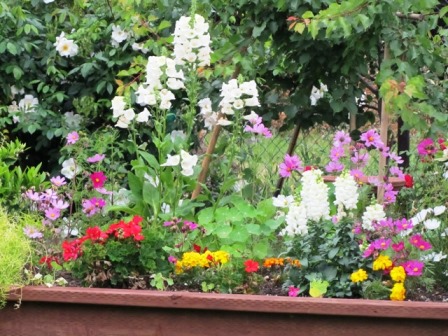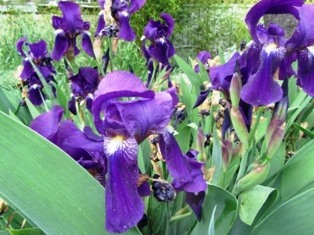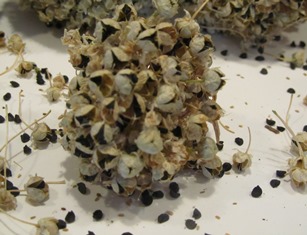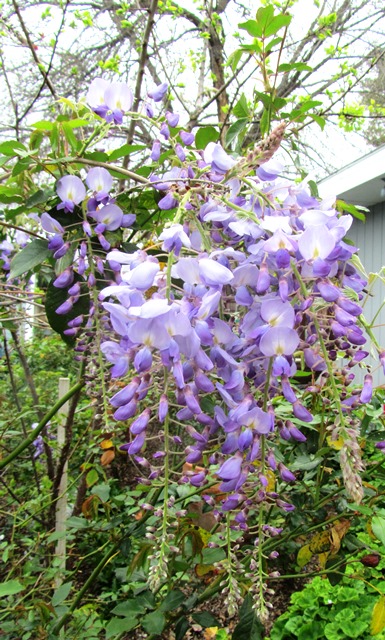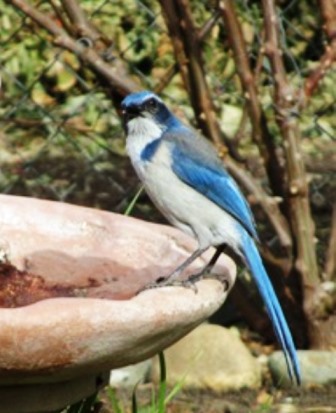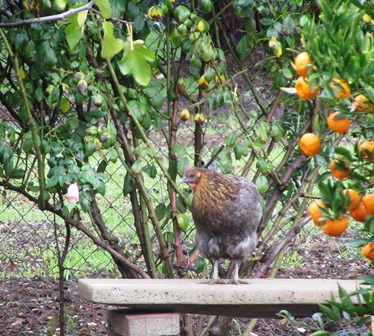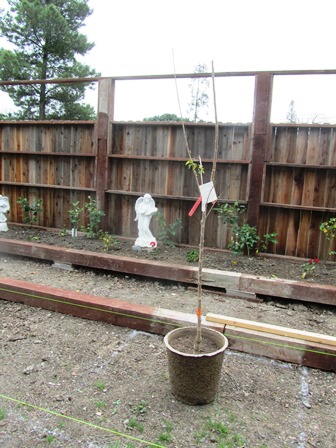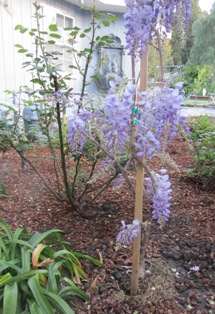How to Attract Local Pollinators
Today, I spotted a gorgeous bee, big and black with reddish-brown wings, dipping its proboscis into the lavender wisteria and other blooms in my garden. I was stung by a bee yesterday, but that doesn’t stop me from smiling with delight observing this little pollinator at work in my garden.
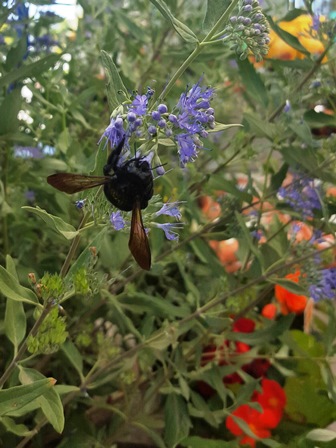
This longhorn bee, twice the size of a honeybee, dips its proboscis (meaning, tongue, nozzle, or snoot) into a bloom.
I admit I’m a fan of pollinators and enjoy watching them work amid the sunflowers, zinnias, cosmos, wisteria, and other blooms in the bee and butterfly garden I planted earlier this year.
The flowers attract hummingbirds, butterflies, bumblebees, and other types of bees, including my own Italian honeybees, the stock of bees most favored in this country (Apis mellifera ligustica). See, http://beesource.com/resources/usda/the-different-types-of-honey-bees/
Honeybees pollinate 90 percent of North America’s commercially produced crops, including almonds. That’s why many Northern California almond growers rent honeybees for use in their orchards during springtime bloom.
The National Academy of Sciences has noted that pollinators are needed to reproduce 75 percent of the Earth’s flowering plants. But there’s been a drop in natural pollinators, in part due to habitat loss and pesticide use.
Populations of the yellow, black, and brown Western bumblebee, once common from southern British Columbia to central California, have now all but disappeared. To attract bumblebees, plant giant hyssop, milk weed, and nettle-leaf horse mint. See, http://www.wildflower.org/collections/collection.php?collection=xerces_bumble
Here’s what else we gardeners and farmers can do to attract local pollinators.
1. Avoid using pesticides.
2. Plant bee, bird, and butterfly friendly native plants.
3. Choose plants that flower in varying diverse colors and shapes to attract a wide variety of pollinators.
* * *
If you enjoy reading about farmette topics (including gardening, beekeeping, and delicious recipes), check out my cozy mysteries A BEELINE TO MURDER and also THE MURDER OF A QUEEN BEE in the Henny Penny Farmette series (from Kensington Publishing).
These novels are available through online retailers such as Amazon, Barnes & Noble, Kobo Books, and Walmart as well as from traditional bookstores everywhere.
See, http://tinyurl.com/hxy3s8q
Now available in mass market paperback, this debut novel launched the Henny Penny Farmette series of mysteries and sold out its first press run.
See, http://tinyurl.com/h4kou4g
The second cozy mystery in the Henny Penny Farmette series, available Sept. 27, 2016
Gathering Seed for Next Year’s Garden
The sounds of summer around our farmette have grown quieter. It’s mid-August and the neighborhood children have returned to school. I miss their laughter. I miss the delight on their faces at seeing the chickens and the honeybees. I miss keeping them company at their lemonade stand.
But I admit to the secret pleasure of solitude and quiet, though it isn’t really silence. It’s the peaceful clucking of chickens and the twitter of songbirds as I gather seed from plants that have bloomed and dried, such as the cosmos, nasturtiums, sunflowers, and wisteria.
The wisteria vine that exploded in growth of long, green tendrils during spring and early summer and graced us with bracts of purple perfusion now hold heavy pods. The pods contain seeds that can be dried and planted for new vines next year.
The sword-shaped leaves of the irises are dry–their blooms a memory from early spring. I’ve already cut their long leaves back into four-inch fans and will dig some of the rhizomes for replanting in other beds around the farmette.
The sunflowers that the bees love to forage on have gone to seed. Those seeds will become next year’s plants, but some we’ll save for the squirrels.
The red and yellow onions have developed seed pods on long shoots now. I’ll plant those in raised beds in the fall for a spring crop of onions.
Yes, the dog days of summer have come around again. But the growing season continues. End of summer gives rise to autumn when grapes, persimmons, pumpkins, figs, and pomegranates ripen. On the farmette, there is always another season and other crops to look forward to with anticipation. It’s the good life.
Flowers, Nest-Building, and Bee Swarms . . . Spring Has Arrived
The wisteria hangs in long purple bracts, its color finding resonance in the grape hyacinth blooms and the lavender buds. Delicate blossoms of pink and white create canopies of color for the fruit trees, and birdsong fills the air. Spring brings its gifts.
As the blue jay creates a screeching racket to the mockingbird’s ready song, the white-crowned sparrows have taken up residence in a row of birdhouses we’ve placed high on the back fence.The entrances of the sparrow houses are too small for the jay to access; a good thing since jays have earned a reputation as nest robbers.
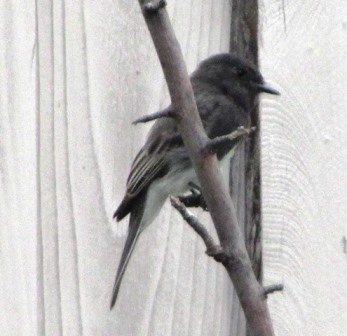
Crew Cut, our resident black phoebe, nests under an eve of the old chicken house; the male teaches its young to catch insects on the wing
Yesterday, I spotted the black phoebe pulling a piece of coir from a wall planter for its nest. These peaceful birds make a sound of tsip or fi-bee, fi-bee and can rise to roughly 50 feet to sing to a female.They range from California to central Texas, and even venture all the way to Argentina.
In the tallest eucalyptus on the acre that stands vacant behind our property, a pair of hawks are also nest-building. My farmette lies in their flight path. Not a good thing to see–hawks swooping down over my chickens and then rising to their lofty nest.
I threw some wildflower seed in beds over the weekend and then, after spotting my neighbor’s errant hen who flew to our yard, I began to regret my action. What can I do now but hope that she’ll not devour the seeds with her constant hunting and pecking?
Last night, I could have sworn I heard the pitter-patter of raindrops against the stone patio floor. With a steaming mug of coffee in hand at four o’clock this morning, I ventured outside and sure enough . . . it was still sprinkling. Hooray! It’s our first spring shower!
So, with all the nest-building and Mother Nature dropping a shower upon us, I know the wildflowers are blooming, too. That means the honeybee season is upon us. My neighbor has already had a bee swarm. I’m not ready, but I can’t stop Mother Nature from beginning a new cycle of seasons just because I don’t yet have my new honey frames assembled. That’s not how it works. Ready or not, spring has arrived.
The Start of Something Wonderful . . . Spring!
I jumped at the chance to visit my favorite nursery this past weekend after my husband suggested a drive to Livermore, California. Alden Lane Nursery occupies a beautiful setting amid ancient oaks and there is even a honeybee hive on the premises. Wisteria blooms in perfusion there this time of year.
We came away with some pepper plants, two smoke trees, and four cherry trees, including Bing and Black Tartarian, its pollinator.
We are going to plant the cherry trees at the front of our property and the smoke trees will go in that area as well. We’ve done very little landscaping on the front of our land, preferring to get the trees and gardens in at the back near our hives and chicken run.
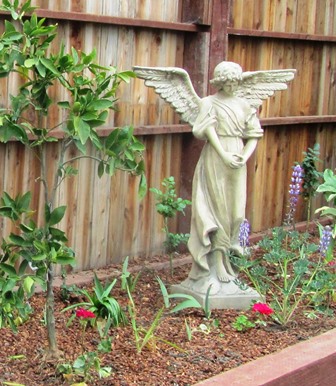
The beds that run the length of the fencing at the front of the farmette feature statuary, citrus, and bedding plants
Everywhere you look on the farmette, there are projects to be done. We chip away at them when we can. My husband works days and I write my novels, so the work will undoubtedly be never-ending. But that’s okay. We aren’t in a hurry and it’s easier to just live by the cycles and seasons of nature.
When I think of how the peaches and apricots are forming and the bees are almost ready to swarm, I know spring is here. And it’s my favorite season, so I’ll go outside, ignore the projects, have a cup of tea, and enjoy the start of something wonderful!
Certain Plants And Chickens Don’t Go Together
Chickens are curious creatures. Spend a hour watching them scratch, poke, and peck and you’ll see what I mean.
I’ve never lost a free-range chicken because of something it ate; but it seems as though they’ll eat anything. It got me thinking that a variety of plants commonly grown in landscapes and backyard gardens could make chickens ill if they ate the berries, nuts, or leaves of those plants.
The following represents a small sampling of common plants that could make your feathered friends sick or even poison them.
- Acorn
- Alfalfa
- Azalea
- Daffodil
- Eggplant
- Foxglove
- Hemlock
- Jasmine
- Jimson Weed
- Lamb’s Quarters
- Lantana
- Milkweed
- Nicotiana (tobacco)
- Oleander
- Oxalis
- Poison Ivy
- Poison Oak
- Pokeweed
- Pyracantha
- Red Maple
- Rhubarb
- Sweet Pea
- Tulip
- Wild Onion
- Wisteria
Chickens are foraging birds and have good natural instincts. They will taste a plant and if something isn’t right, they’ll likely leave it. If you allow them to forage for themselves in pasture, more often than not, they’ll eschew the poisonous plants in your garden or landscape for the rich diversity of what they find in open pastureland.
Attracting Butterflies into Your Garden

The Western Tiger Swallowtail, shown here on geraniums, resembles its counterpart, the Eastern Tiger Swallowtail
While sipping my morning coffee today, I spotted a Western Tiger Swallowtail butterfly in my garden. So naturally, I had to put down my mug of coffee and grab my camera.
These beauties have wingspans stretching up to four inches. The butterflies are often seen in woodlands around streams and riverbanks or canyons in the west. For a complete list of butterflies for Northern California, see http://www.thebutterflysite.com/california-butterflies.shtml
Here on the farmette, these beautiful butterflies feed on the nectar of the garden plants. I often see them on the blooms of my hedge of lavender and elsewhere on the zinnias. They also flit over and and perched on the water fountain near where I grow roses and wisteria.
You can attract these particular butterflies into your Northern California gardens by planting petunia, Mexican sunflower, dianthus, and the butterfly bush. But do a little research on creating a butterfly garden if you want to attract different types of butterflies. And don’t use pesticides or insecticides if you are serious about creating such a haven.
Spiffing up the Farmette for Easter
Finding inspiration in books I wrote long ago, I ‘ve been sprucing up the house and grounds in time for Easter weekend. Family and friends will be visiting. Rain has helped our roses to start blooming and the wisteria is manifesting gorgeous purple bracts in a new garden area where we’ve planted a dozen new rose bushes.
The richly woven linen-and-silk tablecloth I purchased at a sidewalk market in Greece (during the writing of my Everything Women of the Bible book) provides a formal look to the dining table. I added matching napkins and some vanilla- and mocha-colored candles in tall stemmed crystal holders to create a formal look.
In the living room against a raspberry colored wall, I positioned on the piano a pair of French style lamps with tall top hat shades. The ambiance of the informal but warm living room seems to invite conversation.

The Nyjer seed feeder beyond the kitchen window attracts finches while daffodils on the window sill cheer the cook
I love the greenhouse window in the kitchen but hanging a bird feeder outside reminds me (and my visitors) that here on the farmette, nature is never far away. Looking through the window from the kitchen got me thinking about flowers and floral patterns.
Years ago, I wrote a book titled, Blooming Rooms, with my friend and fellow writer A. Bronwyn Llewellyn. We divided up the writing of the chapters based on rooms of a house. She wrote the chapter on kitchens and one of her brilliant ideas was to decoupage a serving tray with antique flower seed packets. Thinking about that book inspired me to bring some flowers into my kitchen. I searched for a pretty vase, filled it with water, and plunge into it a fistful of daffodils.
Finally, I believe our little home sweet home is ready to receive company.
 Facebook
Facebook Goodreads
Goodreads LinkedIn
LinkedIn Meera Lester
Meera Lester Twitter
Twitter





